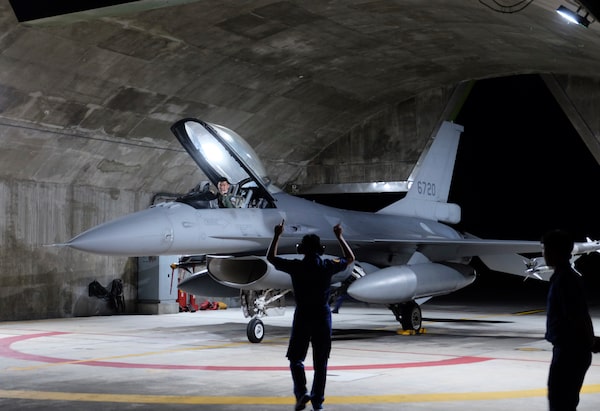
A Taiwanese airforce F-16V fighter jet takes part in night drill from the Hualien Airbase in Taiwan's southeastern Hualien county on Aug. 17.Johnson Lai/The Associated Press
Robin Hsu’s radio squawks with activity on a scorching tropical afternoon in southern Taiwan. As the former naval radar operator fiddles with the controls, an increasingly familiar warning can be heard clearly.
“To the People’s Liberation Army aircraft flying at an elevation of 4,000 metres,” a Taiwanese military official says on an open radio channel. You “are jeopardizing aviation safety. Turn around and leave immediately.”
An increasing number of Chinese PLA warplanes flying off Taiwan’s coast are prompting Taipei to scramble jets to respond to these flights, a pattern that Taiwanese leaders say is designed to exhaust and harass their air force – but is also to plan for invasion.
Mr. Hsu, 50, a radio enthusiast who once worked in a Taiwanese naval combat information centre, has built a social-media following publicizing the Chinese warplane flights as well as the terse and scripted messages that Taiwan, China and U.S. militaries broadcast to each other. He has more than 26,000 followers on Facebook.
‘We share the same blood:’ Small minority in Taiwan would welcome reunification with China
The Chinese plane drawing Taiwan’s attention on this particular day is a Y-8 anti-submarine warfare plane. Mr. Hsu speculates the PLA aircraft was scanning for submarines hiding in a deep ocean basin in the Taiwan Strait between Taiwan and China. “Any form of military training is always preparations for war,” he said while monitoring his full-band radio receiver from a café overlooking the strait.
Taiwan’s Ministry of Defence later said on Twitter that its combat air patrol aircraft were dispatched to respond to the Y-8, which crossed the median line in the Taiwan Strait.
That’s the midpoint in the waterway between Taiwan and China that Taipei says was previously tacitly accepted by Beijing as an unofficial buffer between the two.
Taiwan, a self-governed island that for more than 70 years that has resisted Beijing’s efforts to bring it under mainland rule, has accused China recently of trying to shift the balance of power in the 180-kilometre wide strait by abandoning the median line.
A map released by the Taiwan Defence Ministry showed the PLA’s Y-8 sub hunter crossed the median line and then turned around and headed home.
Taiwanese legislator Wang Ting-yu has become familiar with the thunderous sound of jet fighters taking off from the air base near his home to chase these aerial incursions from China. Last month, he said, one patrol launched as early as 6 a.m. local time.
Mr. Wang, a senior member of his Parliament’s foreign affairs and defence committee, said the Chinese flights are costing Taiwan’s military.
Taipei’s government in August proposed an increase of more than 13 per cent in its 2023 defence budget over 2022 shortly after China conducted live-fire drills that encircled Taiwan in the wake of a visit by U.S. House Speaker Nancy Pelosi. The increase includes an extra 27.1-billion Taiwan dollars ($1.2-billion) for defence operations to account for extra fuel and maintenance required by Taipei’s aircraft and naval vessels.
But Mr. Wang said the flights have another purpose.
“They are practising how to enact a blockade or invasion,” he said.
Chinese President Xi Jinping has vowed Taiwan will one day be brought under Beijing’s control and China has not ruled out the use of force. Last year, U.S. Admiral Philip Davidson, then-head of Indo-Pacific Command, told a U.S. Senate committee that by 2027 Beijing will have acquired the capacity to seize Taiwan.
Mr. Wang said the Chinese military flights sometimes combine fighter jets with planes carrying airborne radar systems used to detect incoming aircraft and ships. Sometimes the PLA flies a combination of bombers and fighters. Sometimes it’s electronic warfare planes.
He said this “harassment” has been growing since 2013 when China ramped up modernization of its air force and navy.
The number of Chinese warplanes headed toward Taiwan are way up in 2022, Mr. Hsu’s logs indicate.
He counted 919 warnings by the Taiwanese military to Chinese aircraft between Jan. 1 and Sept. 29. That’s up more than 70 per cent from 539 in the same period in 2021. Mr. Hsu cautions his records do not include all broadcasts, but they nevertheless capture the trend.
Mr. Hsu said over the years other Chinese military planes he’s tracked include H-6 strategic bombers, J-16 fighters, Sukhoi Su-30 fighters and Chengdu J-10 combat aircraft.
The radio enthusiast said he’s faced criticism for publicizing the conversations between Taiwanese and Chinese militaries. “A lot of people think it’s national secrets,” he said.
But Mr. Hsu said he’s doing his part to help raise awareness of the tensions between China and Taiwan.
He points to a saying, written in Chinese characters, on his shirt: “Same island; one life,” which is the equivalent of the English expression, “We’re all in the same boat.” The phrase, which was popular on social media as Taiwan grappled with the COVID-19 pandemic, was also a common refrain in the 1950s when the PLA was shelling the Taiwanese holdings of Kinmen and Matsu.
“If we all don’t co-operate to fight any threats we’re all doomed,” Mr. Hsu said.
-With a report from I-Hwa Cheng
 Steven Chase
Steven Chase